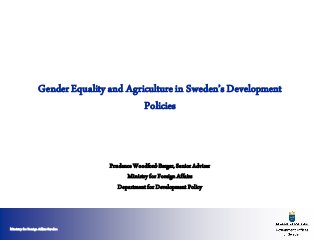
Gender Equality and Agriculture in Sweden’s Development Policies
- 1. Ministry for Foreign Affairs Sweden GenderEquality and Agriculturein Sweden’s Development Policies Prudence Woodford-Berger, Senior Adviser Ministry for Foreign Affairs Department for Development Policy
- 2. Ministry for Foreign Affairs Sweden Sweden’sapproach in development cooperation - pointsof departure • Policy forglobal development (coherence, goals, poor people’s perspectiveson developmentand human rights perspective) • genderequality is botha goal and a prerequisite for long-term democratic development to reduce poverty and achievean equitableand sustainable global development • genderequality and women’s empowerment, like poverty, have many dimensions and face many challenges; entrenched resistance • despitesome improvements, many countries are experiencingan increase in poverty levels and weakening of social protection mechanisms,especially for women and girls and their enjoyment of humanrights • Slow progress towards several of theMDGs particularly MDG 5 but also MDGs 1 and 3 • Women and girls areoverrepresented among thepoorest people. • Gender equality is not a women’s issue. Responsibility to achieveit concerns menas well as women, and both girls and boys.
- 3. Ministry for Foreign Affairs Sweden Effectsof the crisesthat can particularly affectwomen and girls • loss of employment/economic buffers, decreased livelihood security • insecurity of food production and provisioning leading to malnutrition, anemia and compromised immune systems • less access to financial markets and services, and to other resources, particularly for those in rural and coastal communities • increase in unregulated ‘informal’-sector work • increase in unpaid and care work • increase in gender-based violence
- 4. Ministry for Foreign Affairs Sweden The centralityof Agriculture – some key issues • MDG 1 – eradication of extreme poverty and hunger • crucial rights such as to food, health, non-discrimination, participation, education, work; article 14 in CEDAW on rural women • Challenges such as food insecurity, poor nutrition (both undernourishment and malnourishment) • the role of biodiversity, food sovereignty and seed reserves for survival, sustainable livelihoods and resilience at individual, family, local community, district, national and regional levels • monoculture systems; export-oriented agriculture models that often exclude small and subsistence farming
- 5. Ministry for Foreign Affairs Sweden Gender,agricultureand rural development • Rural and peri-urban women and girls must be seen and their voices heard as drivers and agents of social change and development, not just as recipients and consumers but also producers • Visibility of women farmers’ knowledge, skills, experience, aspirations and visions for themselves, their families and communities • Donors must strive to maintain ODA levels and enhance donor coordination with respect to the agricultural sector and rural development, particularly at country level • dialogue with partners to mobilize and sustain commitment to gender equalityand women’s empowerment, and increase support to build women’s and girls’ capabilities in rural and agricultural development processes • women’s and girls’ health including sexual and reproductive health and rights • promotion of rural women’s mobilization for collective action and effective participation in political decision-making and policyimplementation • support to gender-aware agricultural research and to rapid vulnerability assessments in specific countries for better knowledge with the help of embassies and in-country missions in partnership with women’s networks and rural women’s organizations • Meeting women’s needs and rights w r t land and other property,infrastructure, agricultural techniques and new technologies including information and communication technologies, market economy incentives, and freedom fromviolence and sexual harassment.
- 6. Ministry for Foreign Affairs Sweden SidaEvaluation 2010:3– Gender-awareapproaches in AgriculturalProgrammes • women make up a majority of farmers in many developing countries, but the male farmer continues to constitute the conceptual norm for agriculture development planning • resources and incomes controlled by women are more likely to be used to improve family food consumption and welfare • men must be strengthened in their roles as providers of household food security and well-being in order to reduce the burden of responsibility upon women • programme impact affected by gender perspectives not mainstreamed in the programmes studied in Ethiopia, Kenya, Mocambique, Nicaragua and Zambia. Women benefitted less than men. Despite some activities targeting women, their performance generally not strengthened. Negative effects on productivity nationally as these countries have high female participation in the agricultural sectors. • However, the Agricultural Support Programme (ASP) in Zambia provides some evidence that fully involving women farmers does indeed result in increased production, productivity and overall farm resilience. • necessary to build capacity and competence in ministries of agriculture and with regard to extension services.
- 7. Ministry for Foreign Affairs Sweden Sweden’spolicy for gender equalityand the rightsand role of womenin developmentcooperation(2010) Goal: gender equality, greater influence for women and greater respect for women’srights. 4 main areas, all of which are relevant for agriculture: • Women’s political participation and influence • Women’s economic empowerment and working conditions • Sexual and reproductive health and rights (SRHR) • Women’s security, including combating all forms of gender-based violence and human trafficking
- 8. Ministry for Foreign Affairs Sweden Addressinggender inequalities • Policy coherence (not just agriculture but a range of other policies – social, financial, trade, legal etc) • Rights perspective, power perspectives • Women and men, responsibilities and decision-making • Knowledge and evidence are key • Dual point of departure:individuals’ capacity and choices but also necessary to change institutions and structures • women’s legal empowerment and access to justice, not least w r t family law and women’s rights in marriage and with regard to children and to property
- 9. Ministry for Foreign Affairs Sweden Genderequalityand women’s rightsand empowerment relatedto agricultureexplicit in othergovernmentpolicies • HIV and AIDS (2008) • Economic Growth (2010) • Environment and Climate (2010) • Humanitarian Assistance (2010)
